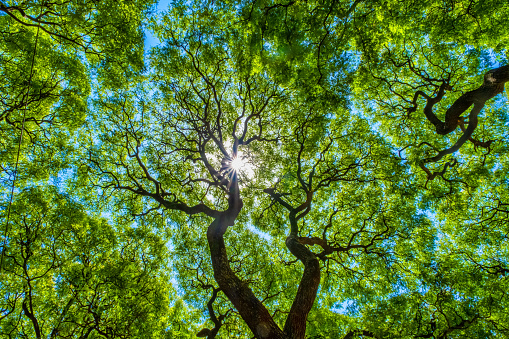Written by Admin and published on https://findthehomepros.com/
When most people think of trees they think of sturdy fixtures that have the potential to live for hundreds of years. Trees can be a great addition to the landscape of any yard. They can provide shade, scenery, and even a cool place for kids to hang out. However, even though trees can be great, there are some types of trees that are simply not good additions to any home. These trees can often cause certain problems, especially when being planted in a yard. Whether it be a high risk of cracking, breaking, killing other plants, or simply stinking up the place – you’ll want to stay as far away from these trees as possible. Here are some types of trees you do not want growing in your yard.
Types of Trees You May Not Want in Your Backyard
Trees make your home’s curb appeal more beautiful, and planting a tree holds the soil in place and provides outdoor shade. Also, trees can be a great natural habitat for woodland creatures and birds. But there are times when a tree can ruin a house’s foundation, block power lines, and cables, and can be more of a nuisance than a benefit.
That’s why it is important to know what types of trees should not be present in your backyard – depending on your location and individual preferences, of course.
Trees You Shouldn’t Plant in Your Yard
Trees that grow in wild areas are not necessarily suitable in residential settings. They can grow so tall and branches out widely, which becomes hazardous and greatly affects your property and compromising your family and other people’s safety.
We consulted with an expert on Tree Removal North Bay residential services. They told us they warn homeowners against certain types of trees not to be planted in the yard. Bringing the wrong tree species on your property may result in continuous and costly maintenance issues.
Here are the types of trees you should avoid growing in your yard:
- Female Ginkgo: While these trees have earned their aesthetic nature and historical reputation, it’s considered a “trash tree” to a residential plantation because the fruits are smelly and messy. A male ginkgo tree is a more friendly option if you want a ginkgo tree added to your property, which is smell-free.
- Bradford Pear: While it offers a decent amount of shade, it only does in a short time. It possesses poor structure and grows too tall rapidly. It causes a hazard during stormy and windy conditions, growing weak branches and causing debris and damage. In addition, the flowers adorn are quite stinky.
- Mimosa: This tree is native to Asia, which is also called the “silk tree” because of its striking pink flowers and frilly leaves. However, the tree has weak wood, so it’s very fragile, which may not withstand rains and winds. It spills its leaves and flowers in different directions, possibly including your neighbors. Also, the seed pods falling from the tree are toxic to small children and pets.
- Silver Maple: It grows quickly and becomes a full-fledged tree but with a shallow root system that stretches wide and far to find moist environments. It can wreak havoc on drainage and sewage systems, tearing up sidewalks ad driveways.
- Siberian Elm: This tree has a high germination rate, growing and spreading aggressively outside its planting site. It has a brittle, weak wood that can be knocked out easily by ice damage and storms. Also, elm leaf beetles usually infest elm trees, easily deteriorating the appearance and integrity of the tree.
- Sycamore Tree: Sycamore has an attractive appearance and elegant structure. However, it’s not ideal for urban or city use. Because of unusual size, the tree grows to magnificent heights, posing a hazard to the surroundings. Also, sycamore trees are susceptible to fungi and pests.
Hazardous Trees Should Be Removed
While all trees are important to preserve the environment, a healthy tree can become hazardous if it can compromise people’s lives and properties. That’s why you have to plant the right trees in your yard.
Here are some examples of hazardous trees:
- Trees that grow rapidly and obstruct the road
- Trees with a widespread root system that may cause damage to your drainage and sewage systems, driveways, and sidewalks
- Trees that can compromise the strong foundation of your home
- Trees with branches obstructing or damaging electrical wires, telecommunications cables, and other necessary human-made structures are dangerous trees
Weak and Sick Trees
Trees may become weak and sick over time, posing safety concerns for homeowners and the entire neighborhood. That’s why proper assessment of your yard trees is important. Contact a professional for help, and if you are looking for a professional in the Rochester and Finger Lakes Region of New York, you’ll find them at FindTheHomePros.com.
Here are the important things you need to look for when assessing the health of your yard trees:
- Weak Branch: A tree with a weak branch that occurs on the main stem and associated with a cavity, a crack,
- or other defects can cause safety problems.
- Cankers: It’s a stem, and a branch’s localized area wherein the bark is missing or sunken, which is an indication that the tree is sick. A canker or several cankers can affect a tree’s more than
- half of its circumference, weakening its structure and causing a safety hazard.
- Root Problems: Root problems of trees may fall without warning. It may result from extensive rot, lowering or raising the depth of the soil near the tree or driving or parking your car over the roots.
Conclusion
The trees mentioned above are perfect in the wild. However, they’re not good for residential areas. You can plant apple, dogwood, cedar, and holly trees instead to provide your yard functional and aesthetic benefits.
Original post here https://findthehomepros.com/types-of-trees-you-may-not-want-in-your-backyard/.

